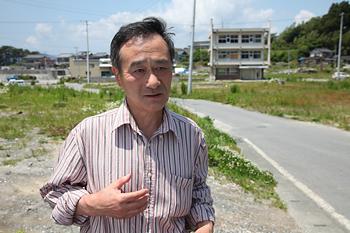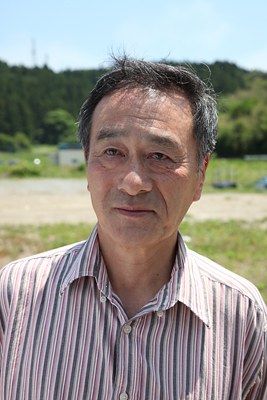Top » Interview » Kakichi Saijo
When I went outside with my camera on the day of the earthquake I was not expecting to photograph anything extraordinary. In the 1960 Chile Earthquake I happened to see the very bottom of the sea exposed just before the tsunami wave attacked. So my intention was to photograph the same phenomenon this time. After I let my wife head for an evacuation area, I decided to head for higher grounds which were overlooking the fishing port. These photos were taken on the way to those higher grounds.

Looking toward the shore, the tsunami gushed over the breakwater wall and started flooding the road which suddenly turned into a river. But rather than following the road heading straight from the shore to the village, the flood progressed in all directions. Although what I saw was an impressive quantity of water, I assumed from past experience that the flood would not progress any further. So at that moment I was still calmly taking my shots.
Contrary to my speculation, the water level rose in an instant. By the time I took the next shot, the tsunami was only 50 meters away from me. At that moment I realized this was something far more serious than what I could imagine and I decided to go further up. At that precise moment very strong aftershock struck. Electric poles were shaking violently and broken wires almost hit my body. I finally felt real danger and dashed up the hill. I was stunned with what I could see from there.

There were 20 to 30 neighbors on the hill, and nobody was saying a word. We were all watching with astonishment our homes, vehicles and the entire village being washed away. Thinking back, no one could grasp the reality, witnessing the event which was beyond men's' belief. I myself, who was taking photos of the tsunami, was in a state of shock. And maybe that's why I could actually photograph such a dreadful scene. A month later when I took a look at my photos developed by my son, I really thought it was not appropriate to take such photos.
In fact I couldn't take any photos for a while after that day. My hometown completely destroyed, having lost my house and belongings, I was nearly crushed by the reality lying in front of me. I didn't want to show anybody the photos I took that day. All homes, vehicles and fields, everything in these photos belongs to people I know. I am not a photo journalist and considering feelings of those people, there was no way I could exhibit these photos.

However, it was people in the community who persuaded me to do so. "This reality must be recorded for the future generation", "These photos may save future lives." Hearing these comments, I got to understand the power of photography. I got convinced that photographs gain value with time. This is why I decided to resume my photography.
My house lost and my retired life uncertain, I sometimes feel depressed. Still, I want to stand strong. Hand to hand, people in my community are making their best toward reconstruction and we are supported by numerous people such as volunteer workers. Also I've met many great people through the exhibitions. The earthquake may have taken away a lot of things from me , but it also brought me many precious things. That is why I want to keep my motivation, help others and go over this great difficulty.
Kakichi Saijo

Born in 1943. Ex officer of Rikuzentakata city. He purchased a camera when his son was born. Since then he has been photographing his family and the everyday life of his community. Fortunately he didn't lose any family member, but had to fully dismantle his damaged house. Currently he has put his mother in a local care house and is living with his wife temporarily in Morioka-City where his son lives.


